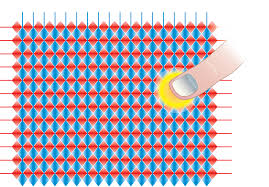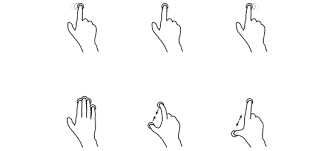We offer 2 types of touch technology throughout our product ranges. Infra-Red (IR) and Capacitive Touch (PCAP).

Infra-Red
Infra-Red works by installing a IR touch frame to the product and the frame fires beams of infra-red light across the glass. When you go to touch the glass on the screen, you are actually breaking these beams of light and the system recognises a touch point. The main benefit is that you can use anything to touch. A finger, a pen, anything.
The benefit of infra-red is its usually a cheaper option, its VERY reliable and doesnt go wrong very often. However, because its built into a frame that attaches to the protective glass, it means that every product with infra-red has a small bezel (about the thickness of a pound coin), so you never have a completely flat surface. Not a problem for most people, but for some it does.
The main issue with infra-red is when its put into any of our products that lay flat like tables. If anything drops into the beam of light when you are touching the table such as a cuff from a shirt or a tie, then the system will recognise that as an extra touch. Again this is not a major issue, as you do get used to how to touch, but if its a product for small children or older people, it may be a constant issue.

Projective Capacitive
This technology is the same technology that tablets and phone use. Its a skin that goes underneath the protective glass in our products, and therefor allows a completley flat surface to be presented. Very aesthetically pleasing! It needs to be touched by something that is conductive such as a finger, or a special stylus.
Generally its more expensive than IR, however, as it needs to be touched with a finger, when its in a product that is flat like a table, you can put non conductive items onto the table and the system will ignore it. such as a book, or a cup.
Again, this technology is very reliable, and very accurate.
Touch Points Explained
 When you are looking at our technology you will see that you pay more for more touch points. So what do we mean by touch points? Well its easily explained. If you can imagine a person using one of our screens and they use the pinch gesture to make a picture go bigger. That requires 2 fingers or 2 touch points. So if you had 2 people using a screen and they both used the pinch gesture at the same time, that would be 4 touch points.
When you are looking at our technology you will see that you pay more for more touch points. So what do we mean by touch points? Well its easily explained. If you can imagine a person using one of our screens and they use the pinch gesture to make a picture go bigger. That requires 2 fingers or 2 touch points. So if you had 2 people using a screen and they both used the pinch gesture at the same time, that would be 4 touch points.
For most people 10-32 touch points is fine and pretty future proof. However, if you want to use object recognition, then you will need to have 32 touch points or more. The reason is explained better in this explanation.

